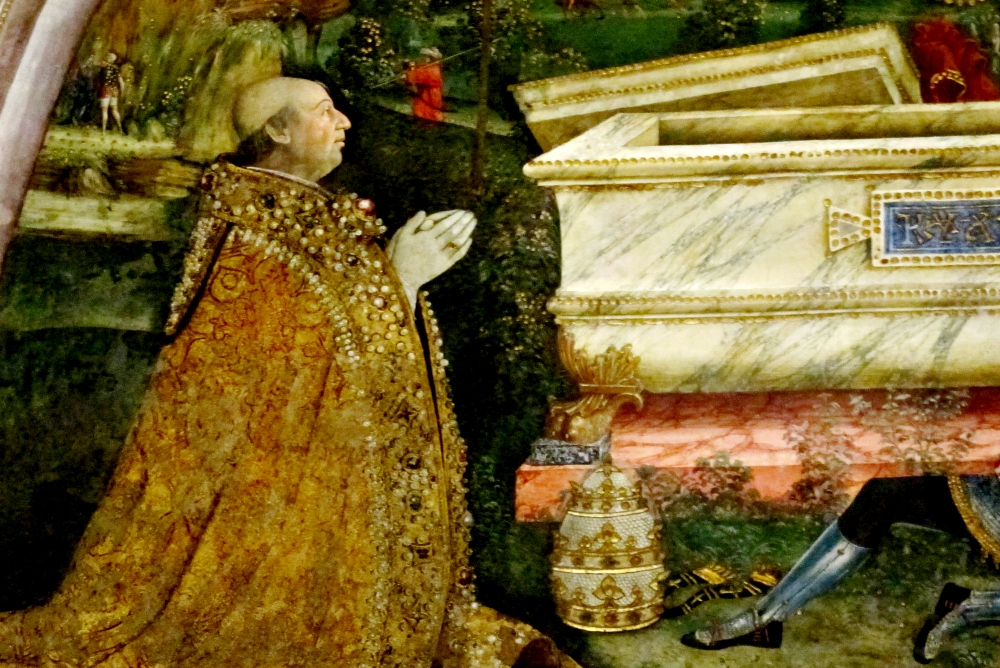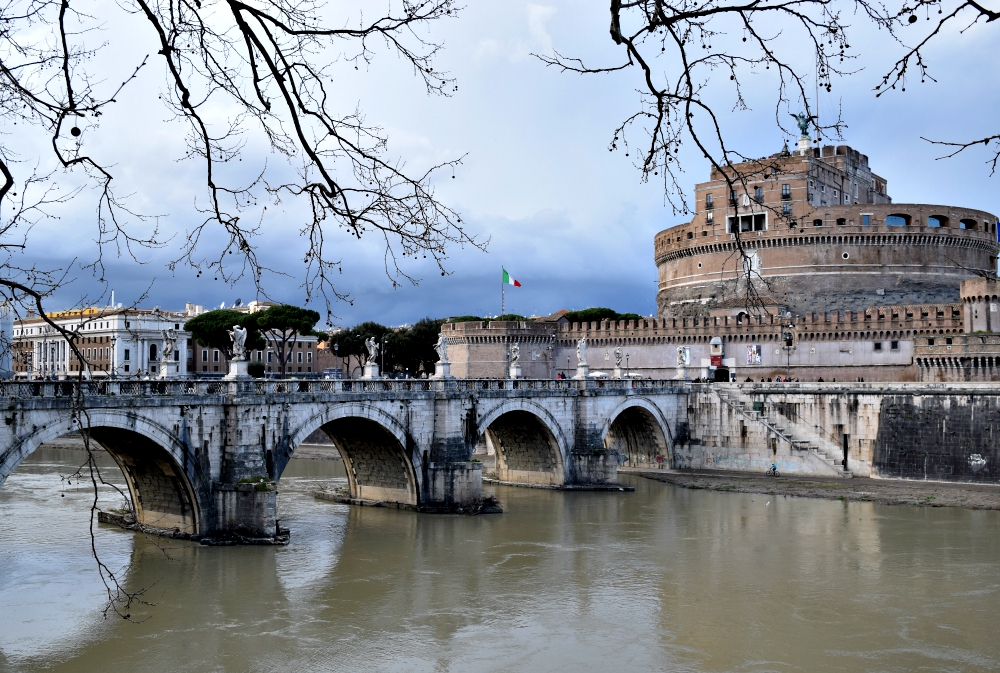
Pope Alexander VI (1492-1503) is depicted at prayer in a fresco by Pinturicchio in the Borgia Apartments at the Vatican. (Wikimedia Commons/Sailko)
The third episode of CNN's series "Pope: The Most Powerful Man in History" aired last night. Admit it: When you realized they were headed into the Renaissance papacy, you thought, with double irony, "This is going to be rich." But, again, CNN surprised by resisting the temptation to luridness and sensationalism, rounded up some good commentators, and managed to make a profound spiritual point in the process.
The show gives you a map right at the beginning. "From the time of St. Peter through the Middle Ages, popes act as beacons of faith, morality and religious leadership," the narrator intones, "but as church influence expands, the trappings of power will seduce even the godliest of men."
We can parse that sentence and find fault, to be sure. The church had a great deal of influence in the Middle Ages, and the problem during the Renaissance is that the influence becomes worldly, not that it "expands." I do not think it is only "the trappings of power" that seduce, but power itself, the desire to be in control per se, not only what one can accomplish with power.
But these are quibbles. The central point is undoubtedly correct: Worldliness is always a danger even as it is a necessity in an evangelizing church in which a central dogma of faith is the Incarnation. Or as we heard in the Gospel a week ago Sunday, unless the grain of wheat fall to the ground and die ...
The show spends surprisingly little time on the election of Pope Martin V by the Council of Constance (1414-18), a remarkable event that ended the Western Schism but also raised the specter of a more conciliar church, a specter that was shut down definitively within a century at the Fifth Lateran Council (1512-17). Instead, the show moves quickly to the dawn of the Renaissance.
The interplay of several factors — the rise of a merchant class, revolutionary advances in the arts and sciences, the demographic recovery from the plague, the age of discovery both across the seas and with the invention of the printing press — all of these bring about a remarkable moment in Western history.
"The world of Michelangelo, Leonardo, Raphael and a whole succession of popes act as patrons to this huge flowering of the Western imagination," remarks historian Eamon Duffy.
The narrator quickly notes the downside: "But the celebrated advancements in art and exploration come at a hefty price."
And author Sarah Dunant adds, speaking of the beautiful works of art and architecture then being created, "A lot of that work was financed by corruption."
Here, the producers could have been a little more diligent. The rise in wealth certainly was a precondition of patronage in the arts, but was corruption a necessary factor too?

Pope Sixtus IV (1414-84) in a 1475 fresco by Melozzo da Forlì (Wikimedia Commons/Sailko)
Dunant, who writes historical novels, also brings in an oddly modern note, saying, "The thing you have to really remember at this moment in history is that there is no other game in town." Does she think that religious diversity would have served as a hedge against corruption? If so, how to explain Pastor Joel Osteen and other prosperity gospel preachers whose enormous personal wealth and flamboyant lifestyles are the worst kind of corruption of the Gospel message?
The story descends into the muck, as it must, with the murderous Pope Sixtus IV, a della Rovere whose family's prominence keeps it in a state of quasi-war during these decades with the Sforza clan in Milan, the Medici in Florence and, subsequently, the Borgias. In 1478, Sixtus connived to murder Lorenzo de' Medici — while at holy Mass no less — and the assassin succeeded in killing Lorenzo's brother, Giuliano.
It was a grim period in the church's history and the election of Rodrigo Borgia as Alexander VI in 1492 only serves to accelerate the moral turpitude of the papal court. Nepotism flourishes. The pope takes a mistress. Vast sums are spent on art and architecture.
Yet, Alexander also makes his ambassadors throughout Europe permanent residents of the capitals to which they are sent; he averts a total war between Spain and Portugal over rival claims in the New World. In addition to his palace, he spends money on a campus for the University of Rome and restores ancient monuments like the Castel Sant'Angelo.
"To us, that looks like a bundle of contradictions," says Duffy. "How can you be conventionally pious and yet living this kind of contradiction? It's a kind of Latin distinction between the man and the office. People manage to respect the office while being aware that the people who occupy it were extremely fallible."

Castel Sant'Angelo is seen from the Tiber in Rome. (Pixabay/chiararemiddi)
Of the great and beautiful monuments Alexander left us, Duffy comments, "One just has to live with the paradox that these things are products of sin but that they are not themselves sinful. They're wonderful and the world is better for them."
I remember first confronting this "Latin" sensibility and, even as a child, it was obvious that it could serve as a petri dish for hypocrisy. As I have noted before, my mother had drunk deeply from the latent wells of Jansenism in the Irish Catholicism of her age and passed that bias on to her children.
As I grew, I also realized the Latin sensibility also serves as the soil from which a less judgmental and more humane culture can spring. I suspect that if my dear mother were still living and were sitting beside me watching the CNN series, she would be cheering for Savonarola! I did not shed a tear when Alexander sent that philistine to the flames.
Advertisement
These issues are perennials in the life of the church. How could it be otherwise in a religion founded on the belief that God himself became incarnate? The God revealed in Jesus Christ is not capricious as were the pagan deities, but the followers of Christ, like those who worshiped Athena, are capricious, fallible, human. The Renaissance papacy was not only inspired by the divine, it was also inspired by the human, and the church in every age is beset by some measure of moral squalor because we humans can't escape it. Honesty reveals nothing so much as the need of a savior.
At the end of the episode, Duffy says of the current Holy Father: "Pope Francis is simply not interested in the power, wealth, influence aspect of the papacy. He gets up at 5 and he works until 10 p.m. So, there's a kind of focus there that we admire but if everybody was like that, the world would be horrible." And so it would.
"How church corruption funded iconic art": a clip from the CNN series "Pope: The Most Powerful Man in History"
[Michael Sean Winters covers the nexus of religion and politics for NCR.]
Editor's note: Don't miss out on Michael Sean Winters' latest: Sign up to receive free newsletters, and we'll notify you when he publishes new Distinctly Catholic columns.








